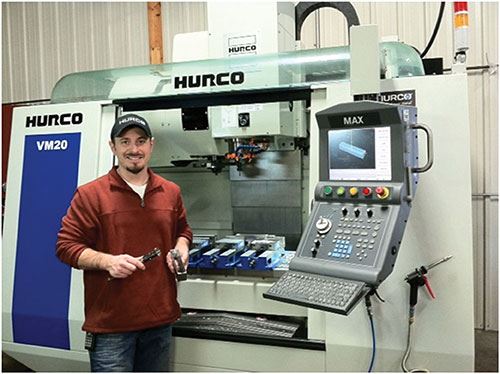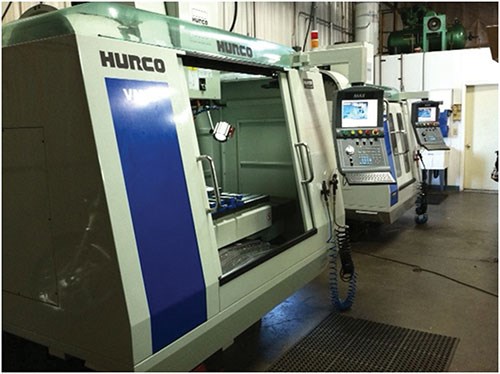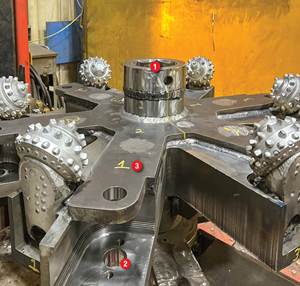Business Grows with Easy-to-Program Mill
By purchasing a Hurco VM10 CNC mill, The Precision Edge Machine increased turnaround of small-batch production by increasing capacity
Share




Takumi USA
Featured Content
View More

Hwacheon Machinery America, Inc.
Featured Content
View More


As business began to pick up for Matt Smith, owner of The Precision Edge Machine, he realized that a CNC mill would add the speed and capacity necessary to take on new orders and continue to grow. In addition to accuracy and reliability, the machine would have to offer conversational programming that was intuitive and easy to learn. With the VM10 CNC mill from Hurco (Indianapolis, Indiana), Mr. Smith says he was able to process some jobs that once took 2 weeks in just 3 days.
Located about 25 miles northwest of Minneapolis in Zimmerman, Minnesota, The Precision Edge Machine specializes in high-tolerance, low-volume parts for medical devices, the aerospace industry and power sports. The shop also manufactures custom wheels and snowmobile parts. When Mr. Smith started The Precision Edge, it was a turning-only shop, but business began to take off after he bought a 1993 KM3P CNC knee mill for secondary milling operations. “I was amazed at how capable a machine of that size was and how easy it was to program,” he says.
Orders of 50 or more milled parts proved difficult to accommodate because the KM3 didn’t have a tool changer. “I was the tool changer,” he says. “Purchasing a CNC mill was a huge decision, but I knew it was time to take the leap.” He purchased the Hurco VM10 CNC mill and he says he never looked back.
One important reason Mr. Smith chose the Hurco VM10 was that the expense and maintenance costs of a CAM package would be difficult for his small startup shop to afford. “Hurco’s WinMax operating system was exactly what I was looking for. It was easy to learn because of the intuitiveness of the control and easy to understand because of its straightforward design. It was everything I needed with no added cost,” he says.
In fact, a former co-worker taught him the basics of the control in just 2 hours. After that, he says he taught himself as he went along. As a “lathe guy,” Mr. Smith says the Hurco conversational control was the perfect solution because it programs like most lathe programmers do—point to point. “It really couldn’t get any simpler,” he says.
Testament to the Control
After implementing the VM10, productivity increased from 15 to 70 completed parts per day. Mr. Smith says sales increased so much that he had to move into a bigger building 6 months later. He also purchased two used turning centers and hired a full-time employee about a month after moving in. Despite having no prior CNC programming experience, the employee learned to program, set up and run jobs with little supervision in 8 months. “That is a testament to the capabilities of the WinMax control,” Mr. Smith says.
Once again, business progressed quickly, and within 8 months, the VM10 became so backlogged with work that he decided to purchase another CNC mill. “The decision to buy another Hurco was a no-brainer,” he says. The shop soon purchased a VM20 with a H160 fourth-axis rotary table. Mr. Smith says it is the perfect size to eliminate the need to fixture parts for complicated side profile machining.
Mr. Smith says one of the most useful features is the DXF Transfer, which enables him to import part geometry from the DXF file directly to the control. While other controls have similar features, he says Hurco’s DXF Transfer has an easy programming interface that enables him to edit DXF geometry, automatically chain contours and select a group of hole operations based on the hole diameter. It also handles all 2D geometries on each plane of the part. The ability to link multiple part planes into a single program increases efficiency for processing complex parts on compound rotary tables.
Verification Saves Money
Another feature Mr. Smith says he finds useful is the Solid Model Verification Graphics. “Bar none, the verification graphics feature has been the most valuable. That feature alone has saved us thousands of dollars because of sudden rapid moves, wrong tool paths, broken tools and scrap materials. You can also see if you fat-fingered a button or put a negative instead of a positive. In that graphics screen, you clearly can see if the part looks like it’s supposed to,” Mr. Smith says.
In the next 5 years, he plans to double his business each year by focusing on improving quality and service, as well as purchasing the right equipment for fast turnaround of small-batch production. “Hurco has been instrumental with the success of our business,” he says. As time goes on, Mr. Smith says he will replace his turning centers with Hurcos.
Related Content
DN Solutions' VMC Provides Diverse Five-Axis Machining
The company’s DVF Series comprises compact five-axis CNC machines that are designed for diverse five-sided or simultaneous five-axis applications.
Read MoreThe Benefits of In-House Toolmaking
The addition of two larger gantry routers has enabled a maker of rubber belting products to produce more tooling in-house, reducing lead times and costs for itself and its sister facilities.
Read MoreThe Cut Scene: The Finer Details of Large-Format Machining
Small details and features can have an outsized impact on large parts, such as Barbco’s collapsible utility drill head.
Read MoreAdditive/Subtractive Hybrid CNC Machine Tools Continue to Make Gains (Includes Video)
The hybrid machine tool is an idea that continues to advance. Two important developments of recent years expand the possibilities for this platform.
Read MoreRead Next
Registration Now Open for the Precision Machining Technology Show (PMTS) 2025
The precision machining industry’s premier event returns to Cleveland, OH, April 1-3.
Read MoreBuilding Out a Foundation for Student Machinists
Autodesk and Haas have teamed up to produce an introductory course for students that covers the basics of CAD, CAM and CNC while providing them with a portfolio part.
Read More5 Rules of Thumb for Buying CNC Machine Tools
Use these tips to carefully plan your machine tool purchases and to avoid regretting your decision later.
Read More




































.jpg;maxWidth=300;quality=90)













